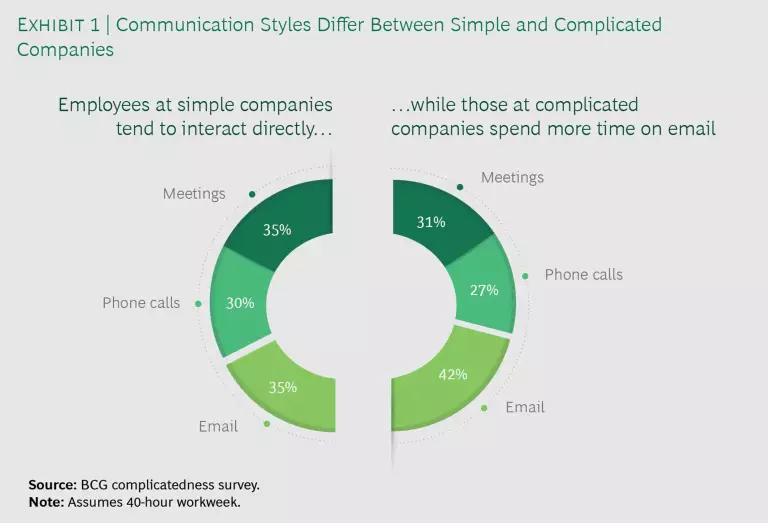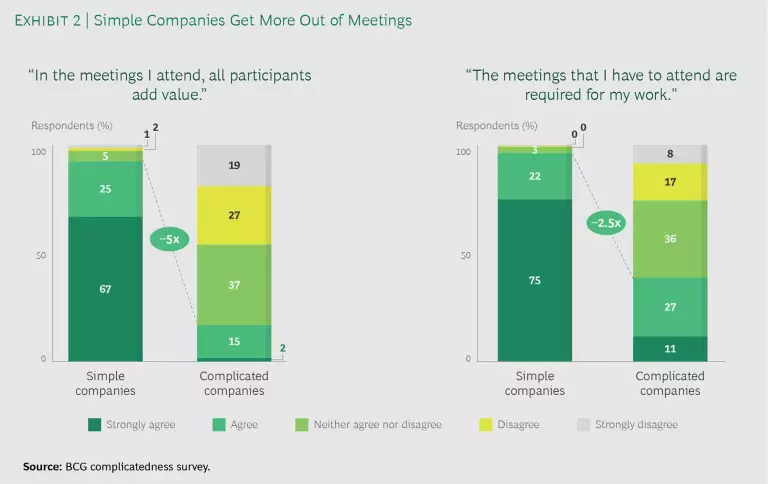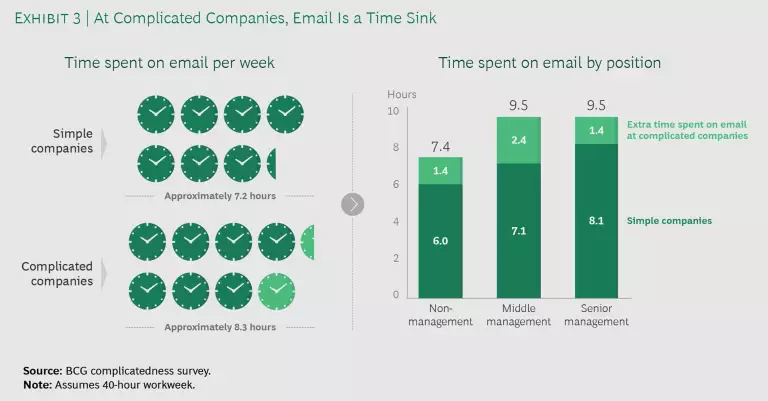It’s popular to bash meetings and email as unproductive time sinks. By some accounts, pointless or poorly organized meetings cost the global economy billions of dollars a year. Corporate communications apps such as Microsoft Teams and Slack have attracted tens of millions of daily users by positioning themselves as a more modern way for coworkers to collaborate.
But meetings and email aren’t inherently bad. In BCG’s latest corporate complicatedness survey, we found that the highest-performing companies continue to rely on these office mainstays. The big difference is not what these companies use but how they wring the most out of them. They stick to specific protocols for meetings and minimize email chains.
Following in high performers’ footsteps of keeping things as simple as possible won’t help an organization streamline a complicated, convoluted collaboration culture overnight. But adopting more common-sense policies for meetings and email is a great place to start. With so many people continuing to work remotely because of the fallout from the COVID-19 crisis, it’s more important than ever for work-related communications and collaboration to be productive and efficient.
Why Simple Companies Stand Out
Before we take a closer look at collaboration practices, it’s helpful to understand why being a simple company is something to aspire to.
Over time, the external factors that organizations must deal with have become increasingly more complicated, leading to an exponential increase in internal procedures, interface structures, and decision approvals. Each year, BCG surveys companies to identify the symptoms of complicatedness and the pain points that can lead to performance issues. In our latest survey, we polled employees at approximately 1,000 global companies to pinpoint the characteristics of organizations that have become high performers by simplifying their processes. We define high-performing simple companies as those that scored in the top quartile of survey respondents; complicated companies are those that fell within the fourth quartile.
Meetings and email aren’t inherently bad; the highest-performing companies continue to rely on these office mainstays.
Our research, which was conducted before the COVID-19 pandemic, found that three-quarters of simple companies have annual revenue growth and profit margins of at least 5%, double that of complicated companies. Simple companies are twice as likely as complicated companies to record robust share price growth. In addition, employees of simple companies are likelier than their counterparts at complicated companies to be happy, proud of their work, and intending to stay with their current employer for the next year.
How Simple Companies Collaborate
Given the amount of time employees spend collaborating, it’s helpful to understand how their behaviors affect complicatedness and what high-performing companies do to simplify.
Employees spend about half their time collaborating—the biggest difference is how. Employees at both simple and complicated companies spend about 50% of a 40-hour workweek collaborating. Employees at simple companies spend about 4% more time collaborating than employees at complicated companies, 20.7 hours compared to 19.8 hours. That’s more time than employees at either type of organization spend working by themselves (30%) or interacting with customers (19%).
The similarities stop there. Simple companies prioritize direct, in-person interactions over asynchronous ones. Their employees spend 17% more time attending meetings, participating in calls, or using other forms of direct communication and 13% less time sending and processing email. (See Exhibit 1.) As a result, they resolve misunderstandings, answer follow-up questions, and reach decisions more effectively.
Because simple companies have more efficient interfaces, clearer roles and responsibilities, and more distributed decision making, their employees get more done. We found that employees in simple companies are up to 35% more likely to have time for focused work, which we define as at least two hours of uninterrupted time per day. They are up to 25% less likely to have to work late to get their work done. This suggests that collaboration at these companies is more likely to be planned and coordinated as opposed to ad hoc. In addition, at complicated organizations, roles and responsibilities aren’t as well defined and interfaces are less efficient, making collaboration less effective and fruitful.
Simple companies run better meetings. Simple companies are less likely to run low-quality meetings—to which people are invited for the sake of being invited, for example—which can lead to ineffective decision making, fuzzy business processes, and lack of trust. Those can all prevent participants from reaching goals or making decisions, which is the point of having meetings in the first place.
At simple companies, participants are likelier to bring more to meetings because only those who are required to be there are invited. We found that 97% of employees at simple companies “agreed” or “strongly agreed” that the meetings they attend are required for their work, compared to only 38% of employees at complicated companies. (See Exhibit 2.) In addition, 92% of employees at simple companies “agreed” or “strongly agreed” that at the meetings they attend, all participants add value, compared to only 17% of employees at complicated companies.
At simple companies, spending less time on email frees up time for other work. It’s easy to recognize companies that overuse email. People get copied on messages that only tangentially relate to their work. Or they copy higher-ups on messages in the hope that it will bring attention to their own performance, lend weight to requests, or give them an out in the event of a bad decision. Chronic email overuse, like holding meetings for their own sake, is a symptom of ineffective decision making or a risk-averse culture in which employees do not feel empowered to make decisions on their own.
Not surprisingly, complicated companies rely heavily on email, while simple companies do not. We found that chronic email overuse leads employees at complicated companies to spend an average 8.3 hours of a 40-hour workweek composing, reading, and responding to messages. (See Exhibit 3.) Simple companies buck that trend. Their employees spend up to 20% less time on email than their peers at complicated companies.
Middle managers at complicated companies have it the worst. In a typical workweek, they devote 9.5 hours a week to email, about 2.5 hours more than their counterparts at simple companies. Senior managers at complicated companies also spend more time on email than their peers at simple companies: 9.5 hours compared to 8.1
How to Collaborate Like a Simple Company
To simplify your collaboration culture, take stock of how the organization uses meetings and email, what you can change to make them more efficient and productive, and how you can make those changes last. Here are some good places to start.
Default to the simplest communication method. Real-time communication is still the best way to address everything but minor issues. A quick face-to-face chat, phone call, or videoconferencing call is always better than an email or a meeting for discussing sensitive subjects or matters that require relationship skills or emotional intelligence, which can be hard to convey in a written note. At one company, employees are encouraged to make a phone call for anything that they need to think twice about. Companies that don’t already have guidelines should develop them to help employees know when an issue is escalating to the point where a call or one-on-one meeting is in order.
Review your meeting culture. Hold meetings when they’re needed, not for their own sake. Eliminate long weekly catchups in favor of short daily briefings. One company we know allots managers a set number of meeting minutes per week and asks them to rate the value they gain from the gatherings based on the number of attendees multiplied by their salaries. Follow the example of simple companies and invite only those who need to attend given what’s being discussed, not their position in the organization. Some companies limit attendees to one per department or team. Allow people to attend remotely as needed. Make sure everyone who’s invited understands that they’re expected to contribute, and allow people to opt out if they don’t believe they’ll add or get value from attending. Once a meeting’s begun, let people bow out if they realize they’re not adding or getting value from it, without penalty. Leaders can set the tone by praising people who decide their presence isn’t necessary.
Simple companies stick to specific protocols for meetings and minimize email chains.
Set meeting ground rules. Create and share meeting agendas ahead of time, along with expectations for goals, outcomes, and decisions. To prevent discussions from veering off-topic, make agenda items as specific as possible, including the results or decisions the meeting is meant to achieve. To emphasize the importance of meetings in decision making, some organizations use templates to specify goals for each agenda item. Appoint a meeting “owner” to manage the meeting and make sure attendees stick to a preset time limit. Circulate meeting minutes afterwards to recap actions and document decisions and deadlines.
Make meetings more productive. Eliminate multitasking and other potential distractions that can make meetings less productive. At one BCG client, meetings became shorter and more efficient after the company banned cellphones. Be realistic when scheduling meetings to avoid running over and affecting people’s schedules. Instead of planning meetings for 30 or 60 minutes, make them 25 or 50 minutes long so people can use the extra time take a break, make a call, check email, get to the meeting location on time, or prepare.
Create meeting-free time blocks. We know from the complicatedness survey results that employees at simple companies are more likely to have time for uninterrupted work and are more productive as a result. All companies can help employees work without interruption by blocking off specific times of the day or days of the week when meetings and visits from outsiders aren’t allowed. In addition, behavioral science research shows that time blocking for heads-down work is most successful when it occurs at the same time every week, applies to everyone on a team or in the company, and is included in organization-wide schedules. BCG’s North American offices, for example, have instituted Focus Fridays, with teams asked not to schedule meetings after 1 pm in order to give people time for focused work or catching up with colleagues.
Train staff in how to use email. Email has been a part of work culture for so long, it’s easy to assume that everyone knows how to compose messages that are short and to the point. But that is often not the case. Hold trainings to teach staff how to write effectively, when email is appropriate or not, and when it’s okay to ignore or delete received messages. Managers need training so they can give their direct reports feedback on email use, just as they do on other forms of written communication.
Consider email alternatives. Some communications are better suited to enterprise communications platforms that encourage public conversations, such as Microsoft Teams and Slack. Such apps allow an organization’s collective knowledge to be stored, searched, and shared instead of locked inside email chains. Companies should combine tools when possible, such as by connecting communications and productivity apps, in order to avoid duplicating work. They also should give employees the tools they need, such as webcams for videocalls, and the training to use them.
Ineffective meetings and email are symptoms of complicatedness. It takes discipline to nurture the culture change required to create the collaborative environment that is synonymous with simple companies. But taking steps to fix meetings and email is a start.
Acknowledgments
The authors thank Georgie Stokol and Sam Ngiam for research, data analysis, and other work that went into producing this article.









